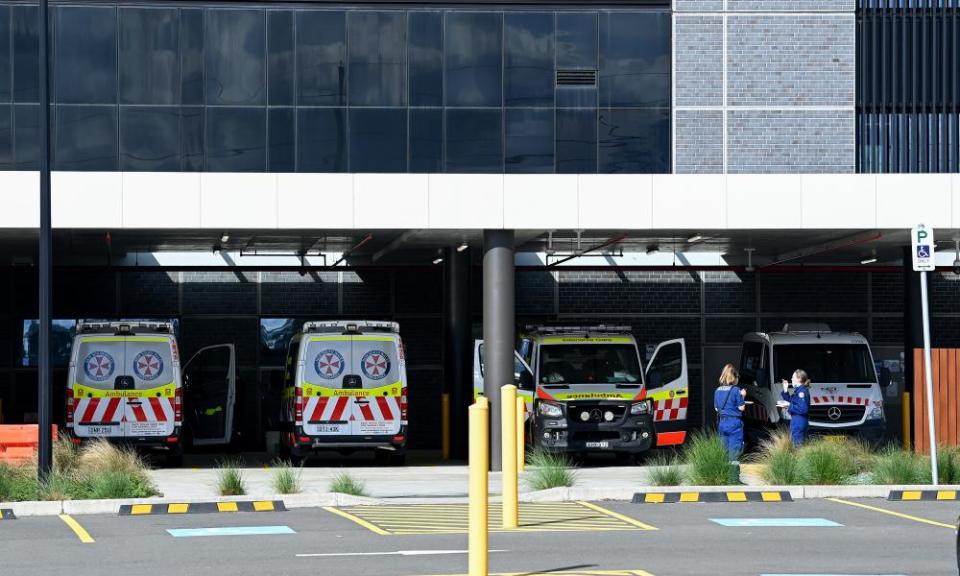NSW has had fewer Covid hospital admissions than predicted but surge expected when restrictions lift

Covid hospitalisations in New South Wales are not growing as fast as previously predicted, however health officials expect pressure on the system to increase due to a surge of cases when restrictions are lifted next month and Covid patients take longer to recover.
On Tuesday, as new case numbers in NSW remained below 1,000 for the third day in a row at 863, there were 1,155 Covid patients being treated in hospital, with 213 in intensive care, 113 of whom were on ventilators.
That’s down on the previous week when 1,266 Covid patients were in NSW hospitals, with 244 in ICUs and 118 of them requiring ventilation.
Related: More than half of the Covid cases who died at home in NSW were unknown to health authorities
While the hospitalisation figures don’t include the roughly 14,000 Covid patients receiving health care in their own homes to avoid further virus exposure in hospital, NSW’s hospitalisation rates appear to be flatlining.
Burnet Institute modelling released earlier in September predicted NSW hospitals would peak at about 3,900 patients, including non-Covid patients, in mid to late October, with the number of people in intensive care peaking at 947 at the beginning of November.
On Tuesday, the NSW health minister, Brad Hazzard, acknowledged the modelling had predicted higher hospitalisations than the reality, attributing the lower than expected figures to the state’s high vaccination rate and measures targeting LGAs of concern.
“Those vaccinations are making a difference to the modelling. And I think what we’re seeing now is at least a hope, at least a hope that we may not get as much pressure as we thought on our hospital system, but that’s by no means clear,” he said.
“We’re still taking a precautionary approach. We’d have to expect, but hope that it doesn’t happen, that the numbers will increase again over the next month. We’re hoping it doesn’t happen,” Hazzard said.
The Burnet Institute’s modelling on hospitalisations did not take into account an easing of lockdown restrictions, which is likely to happen on 11 October.
Chris Moy, the vice-president of the Australian Medical Association, agreed with the NSW’s government’s assessment that its healthcare system wasn’t “totally out of the woods yet”.
Moy said the planned reopening from lockdown, combined with the longer recovery period for Covid patients in ICU and hospital, meant the system could still become overwhelmed.
“What we’re seeing is that on average they spend significantly longer in ICU and hospital in general, and Covid cases will increase generally when restrictions lift.”
Moy told Guardian Australia that even if the vaccinated population who catch Covid don’t go into ICU, they could enter hospital or require healthcare that will ultimately be at the expense of other patients, whether that be in ICU or those receiving non-Covid care.
“They’ll be displacing people either in hospital, outside of hospital or those who will delay their care into the future.
“It’s the accrual of Covid patients in the system that is going to be the issue once we reopen,” Moy said.
Nationally, ICU capacities have not been reached. The health department secretary, Brendan Murphy, said a survey undertaken by the Australian and New Zealand Intensive Care Society had estimated there were currently 2,000 ICU beds in use, with the potential for this to scale up by at least another 2,500 if necessary, with 500 of these beds staffed and immediately available.
Email: sign up for our daily morning briefing newsletter
App: download the free app and never miss the biggest stories, or get our weekend edition for a curated selection of the week's best stories
Social: follow us on YouTube, Facebook, Instagram, Twitter or TikTok
Podcast: listen to our daily episodes on Apple Podcasts, Spotify or search "Full Story" in your favourite app
Murphy said the states and territories were finalising their plans for both surge capacity and a “living with Covid” strategy for intensive care.
“The surge capacity is very different from the living with Covid capacity,” Murphy told a Senate inquiry on Tuesday.
“The important thing is that the jurisdictions are now doing significant additional work to refine what they will see as able to be staffed in that additional capacity.”
Murphy said that last year the department had put in place a “crisis surge plan” that had prepared for 6,000 ICU beds to be in use nationally, with sufficient ventilators purchased to service this many patients.
“The sense at the moment is that that would not be something that could be sustained for more than a serious crisis, which is not something we will now contemplate in our vaccinated population, so a surge plan is planning for significantly less of an ICU capacity for that,” Murphy said.

 Yahoo News
Yahoo News 